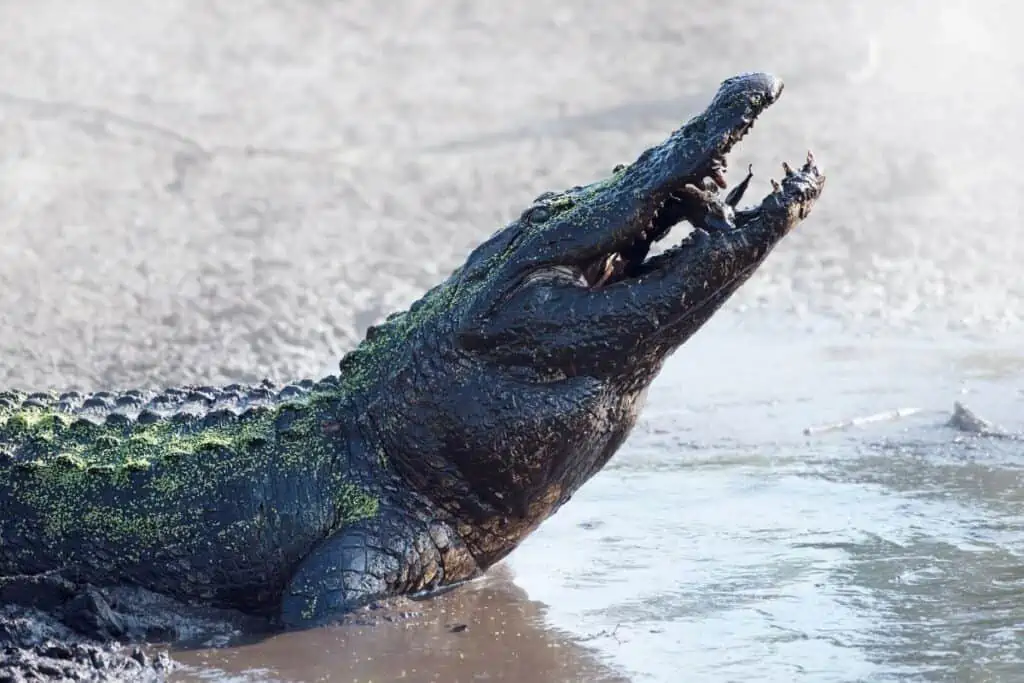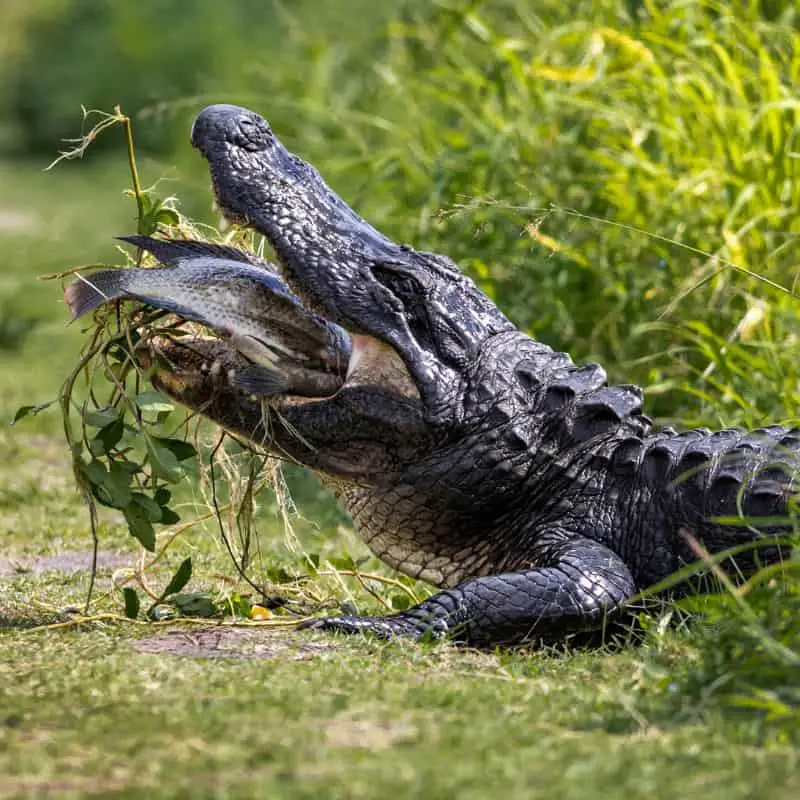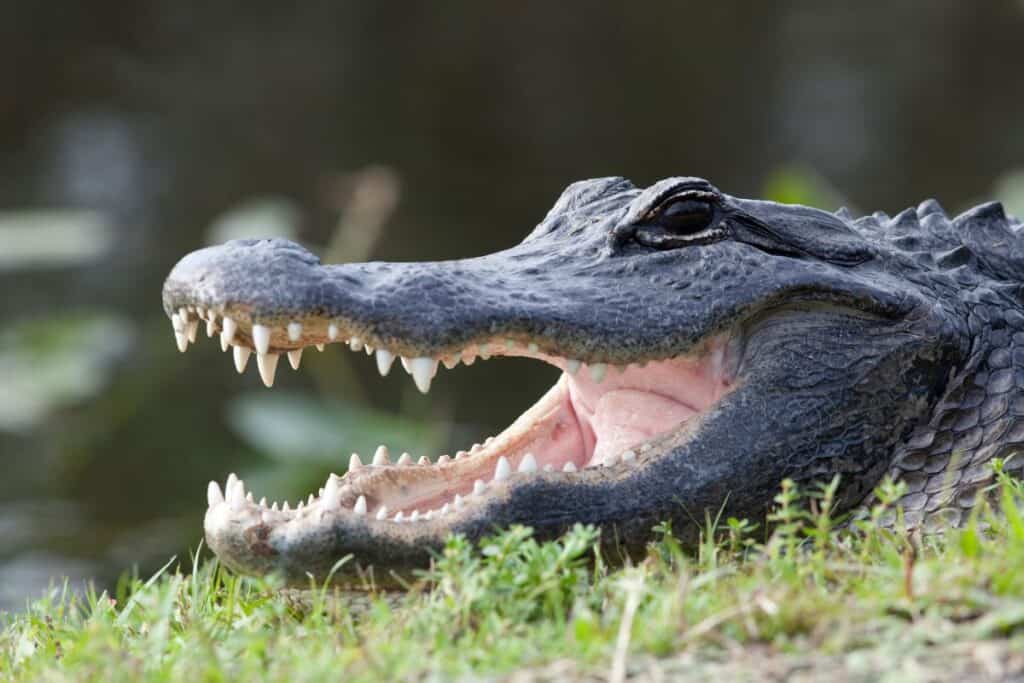As many have witnessed in real life or on national geographic, alligators burst out of the water, pounce on their target, clamp down firmly and drag it under the surface before rolling. They typically drown their victims and move frighteningly quickly in the first onslaught and retreat. But what do alligators eat exactly?
Baby alligators typically eat crayfish, frogs, insects, small fish, bugs, mosquito larvae, snails, and worms. Once gators grow and mature, they eat crabs, small birds, larger fish, and frogs. Fully mature gators eat deer, large birds, beavers, turtles, muskrats, large fish, and snakes.
As ambush predators, they wait while lying in the water or among the bushes. If something is sloshing in the water at an ambush distance, they don’t see deer, large birds, or persons. Instead, they focus on the actual size and consider whether to attack or not.
Here’s all that alligators eat.

All About What Alligators Eat
Alligators are considered predators since they are primarily carnivores. This means they eat meat.
When it comes to what exactly they eat, it can differ depending on whether the alligator is a baby or an adult alligator.
Baby alligators typically eat the following:
- Crayfish
- Frogs
- Insects
- Small fish
- Bugs
- Mosquito larvae
- Snails
- Worms
As you can see, hatchlings feed on tiny prey because in the wild, when they first hatch, they are typically only a couple of inches long.
Like most animals, and even humans, its diet changes as the baby gator grows. This isn’t surprising as a human baby’s diet typically changes from formula and baby food to more solid food like bread.
Alligators that grow in size and become more mature eat the following:
- Crabs
- Small birds
- Larger fish
- Frogs
- Rats
When alligators mature, they can now eat larger prey as they are more capable of hunting, catching, and holding their own against larger food sources.

A fully mature gator that has grown to around four to five feet will typically eat the following:
- Raccoons
- Deers
- Large birds
- Beavers
- Turtles
- Muskrats
- Large fish
- Snakes
An alligator’s diet will be fish and turtles 90% of the time, especially at five to ten feet.
This is because the other animals that they eat tend to take a lot more work to catch compared to fish and turtles that are right in the water with the gator.
They will occasionally eat small mammals and large wading birds.
Alligators in reptile enclosures are usually fed raw meat like raw beef patties, mice, etc. Since they are carnivores, they can also eat some raw meat humans consume, like chicken.
Anything that fits in an alligator’s mouth will be consumed.
This is excellent news for alligator keepers because they will consume a broad range of foods, so they aren’t difficult to feed.
Have Alligators Been Known To Eat Humans?
Typically, they don’t hunt or consume humans. They frequently avoid eating human bodies, even during lethal attacks. The majority of alligators usually consume turtles, tiny snakes, and crawfish.
According to some, due to the relatively large amount of sodium we consume, when an alligator bites us, our flesh doesn’t taste like fish or any of the other tiny mammals they are used to hunting. Therefore they will desert the body after an attack.
Do Alligators Practice Cannibalism?
Some alligators do practice cannibalism, in which they actively seek out and consume other members of their own species if given the opportunity.
And when you think about it, this conduct is not as frightening or out of the ordinary as you may imagine; it is typical among alligators.
Unsurprisingly, adult alligators are just as ferocious, violent, and possessive as their crocodile brethren. They also pounce on any unsuspecting animal that crosses their way since they are opportunistic feeders.
Unfortunately, that includes members of their own species. Especially the young who, because of their smaller size, some of whom are barely longer than 25 cm, are defenseless and make the perfect meal for a large alligator’s voracious appetite.
This carnivorous animal employs the same techniques on the baby gators it uses when hunting various species, including turtles and fish. It either thrashes around while holding its victim firmly in its jaws, or throws the body into the water to shred it into little pieces that can be eaten.
Alligator teeth are unable to chew as human teeth can. Hence when it comes to eating medium- or large-sized prey, the enormous reptiles must resort to tearing their prey into pieces or ripping pieces of flesh off with their death roll.
That, or it merely swallows the baby gator whole. Cannibalism collectively accounts for 50.2% of all hatchling deaths and 63.7% of all deaths of individuals under several months old, making it one of the main reasons for death in the gator world.
Although brutal, this cannibalism is beneficial because it balances the adult alligator population and lowers the adolescent population to mitigate resource competition. It also helps with gator overpopulation, particularly during food shortages or when the environment is at its holding capacity.
How Do Alligators Eat?

Despite having everything they need to chew, alligators don’t. An alligator can be likened to a large snake with a mouth so large that it can devour prey with just a few head bobs. Alligators, and crocodilians in general, use the most horrifying methods of killing and devouring prey.
Some may rip the meat off while the animal is still alive, while others will swallow turtles in mid-stride, others will bite their prey’s necks as lions do, and many will thrash their prey about in a death roll.
Alligators favor eating dead and decaying prey. Typically, they seize their prey and conceal it underwater until it becomes easier to rip apart. While submerged, they do not consume food.
Alligators need to come to the surface to swallow their meal. Otherwise, they would consume too much water along with it.
Alligators have a watertight valve at the back of the throat that closes and shuts the rear while submerged. While underwater, they have an excellent biting ability, but they must surface to ingest their meal.
When Do Alligators Eat?
When in an enclosure, alligators are usually fed twice a day. However, in the wild, it is a different story.
This is because alligators are opportunistic feeders and will only eat when they come across prey.
Therefore, it is possible that they can go for days without eating, and on other days, they can catch multiple preys.
Final Thoughts On What Alligators Eat
As you can see, different stages in an alligator’s life will determine what is best for them to eat
First, they can hold their own because bigger meals help to sustain and strengthen them. The more an alligator matures, the bigger its prey becomes.
Alligators eat in different ways and, unfortunately, also eat their young at times. What alligators eat depends on whether they are in an enclosure or in the wilderness.
